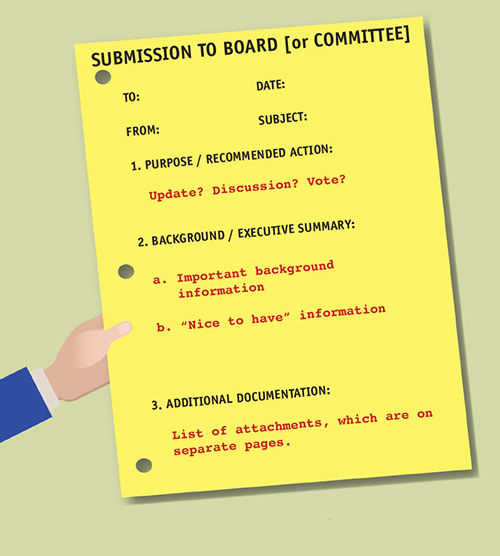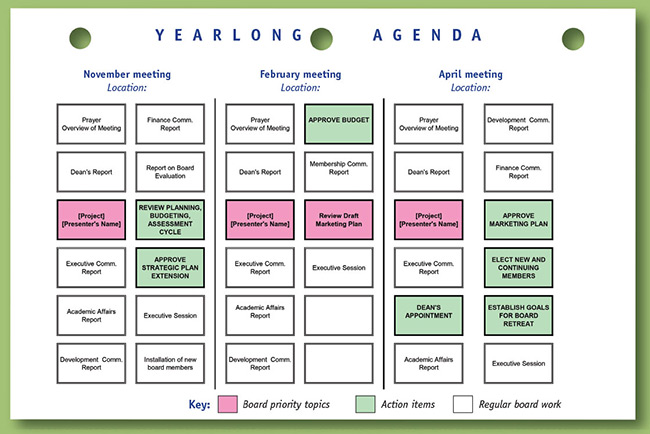A concept borrowed from a high school journalism class is helping board members at Saint John’s University School of Theology and Seminary avoid information overload.
“I’m no journalist,” remarks William J. Cahoy, dean emeritus of the seminary, “but I remember learning how reporters use an upside-down pyramid structure to organize media stories.”
The idea is simple and works equally well in boardrooms as in newsrooms. Information is arranged in a way that accommodates a reader’s level of interest and availability of time. The first paragraph contains the central facts packaged as a no-frills overview. Each subsequent paragraph fills in details in a cascading order of importance. Readers choose how deeply they want to dive into the data. They can opt for the quick synopsis or commit to a thorough review of specifics.
“The reality is that a journalist — or a seminary dean — can’t assume that everyone is going to read a document to its end,” says Cahoy, who managed communications with the school’s board of trustees for 17 years. “What I like about this format is it provides an executive summary of information and then focuses board members’ attention on what they need to do with the information.”
 |
| A one-page cover memo accompanies each item. Preparing the memo requires the discipline to write an executive summary with background information in descending order of importance. |
Ten days before the board’s quarterly gatherings, board members receive a packet that includes an overview chart and a one-page cover memo for each major item on the meeting’s agenda. A subject line identifies the topic, followed by a sentence that describes the reason the topic is on the agenda and states a recommended action, if any, by the board. “We tell them whether this is an update on a previous issue, a new topic for discussion, or something that requires a vote,” explains Cahoy.
The bulk of the cover memo gives pertinent background information, tightly articulated, that puts the issue into context. It summarizes the issue’s origin, tells of progress since the last meeting, and suggests next steps. If a vote is required, a draft of the resolution is offered on a separate sheet.
Supporting documents related to the issue — budget analyses, grant reports, committee notes — supply the details and occupy additional pages. Board members who are pressed for time can skim the cover memo, bypass the details, and have a general understanding of the topic at hand and the action it requires.
“Board members are typically inundated with information,” says Cahoy. “One of the questions they often ask, quite reasonably, is ‘What am I supposed to do with all this information?’” The memo answers that question.
To further streamline the process, different colors of paper distinguish the various elements. For example, cover memos are generally printed on yellow paper, resolutions on blue, and supporting materials on white. This helps trustees quickly pull the right document from the packet as board conversation moves from one item to another.
If the format provides a useful tool for trustees, it also benefits campus personnel who assemble the packets. Complex issues are sometimes difficult to distill to a one-page document, but the exercise instills discipline and helps staff identify and highlight the most salient points.
“This is a way to avoid board members feeling overwhelmed, but at the same time give them as much information as they want,” Cahoy says. In achieving the delicate balance between transparency and expediency, the process has earned high marks from grateful trustees. The best affirmation of its popularity is that trustees tell them that they have recommended it for use by other organizations
Planning a year in advance
To organize a full year’s meetings, Saint John’s uses a template to guarantee that all essential topics are covered. In this simplified adaptation of the template, each item for a year’s meetings is identified on a chart. Regular agenda items are in plain boxes. Priority topics are in pink boxes. And action items are in green. Meetings always start with prayer, an overview, and the dean’s report, and they end with an executive session.
